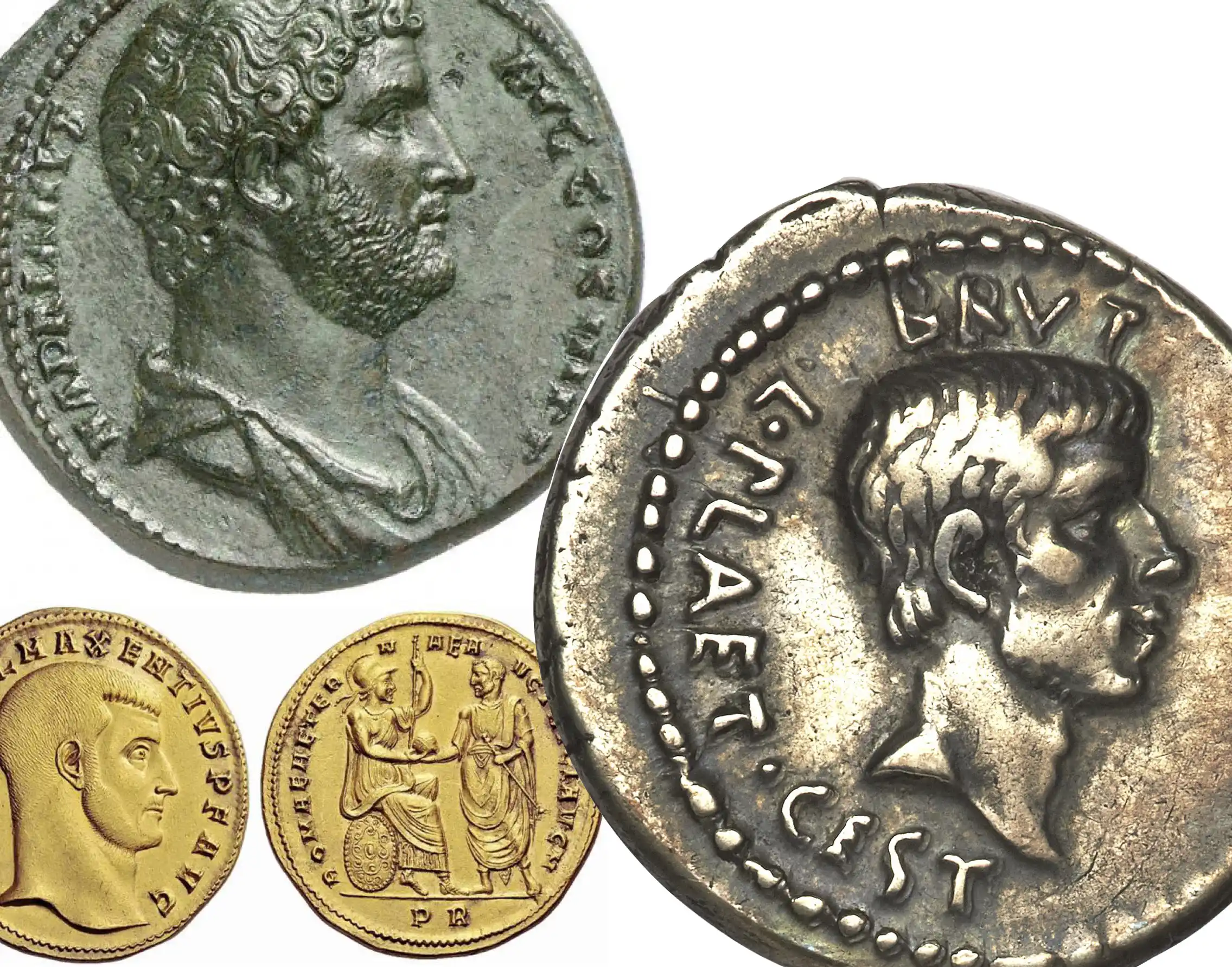Rare Roman Coins: The Ultimate Collector’s Guide
Roman coins aren’t just relics — they’re time travelers in metal form. Every once in a while, a particular coin rises above the rest, not because it’s made of gold or silver, but because of the story it tells. These rare Roman coins offer a direct line to emperors, revolts, lost battles, and historic moments etched forever in bronze or silver.
If you’ve ever held one, you already know the thrill. If you haven’t — let’s change that.
🗡️ EID MAR Denarius (42 BC)
This isn’t just a coin — it’s a political manifesto in silver. Brutus struck this denarius after his role in Julius Caesar’s assassination. On the reverse, you’ll see two daggers and a liberty cap. The bold inscription “EID MAR” refers to the Ides of March — the very day Caesar fell.
Today, only about 100 examples survive. As a result, this coin stands as one of the most sought-after in Roman numismatics. In fact, many consider it the world’s first piece of political propaganda in coinage.
👑 Gold Aureus of Augustus (27 BC – 14 AD)
Augustus, the man who rebranded himself from Octavian and transformed the Roman Republic into an empire, also transformed Roman coinage. His gold aurei weren’t just beautiful — they were statements of power.
Additionally, some rare issues depict early or unusual portraits, including scenes that emphasize peace and divine legitimacy. If you’re building a collection that reflects Roman imperial propaganda in its infancy, an Augustus aureus is a must-have.
🐍 Cleopatra and Mark Antony Denarius (32 BC)
Talk about drama. This denarius shows both Mark Antony and Cleopatra VII — two of the most iconic figures in ancient history — side by side.
While Antony prepared for war against Octavian, he authorized this coin to circulate in the East. The fact that a Roman coin features a foreign queen is rare enough. But symbolically? It speaks volumes about Antony’s loyalties and Cleopatra’s influence.
Coins like this bridge the Roman and Hellenistic worlds — and they make your collection stand out.
🔥 Nero Sestertius with the Harbor Scene (Mid 1st Century AD)
You don’t need gold to own something spectacular.
During his reign, Nero issued a large bronze sestertius featuring the Port of Ostia — Rome’s lifeline to the Mediterranean. The scene includes ships, warehouses, a lighthouse, and architectural detail rarely matched in Roman bronze.
As a result, well-preserved examples are incredibly collectible. They also happen to be museum favorites — several major collections showcase one proudly.
⚔️ Aureus of Aemilian (253 AD)
Aemilian didn’t last long on the imperial stage. In fact, he ruled for just a few months before rivals eliminated him. Because of this, coins from his reign are exceptionally scarce.
Gold aurei struck in his name are even rarer. They reflect the instability of the Crisis of the Third Century, when emperors came and went faster than the coins that bore their image.
For advanced collectors, an Aemilian aureus is a gem — a coin that whispers tales of chaos and ambition.
🦅 Constantine Medallions (Early 4th Century AD)
Not every rare Roman coin was meant for market stalls or legionaries. Some, like Constantine’s medallions, were ceremonial and deeply symbolic.
Struck in gold or silver — and often much larger than typical coinage — these medallions were diplomatic gifts. They honored generals, governors, or foreign rulers, and frequently featured Christian iconography, reflecting Constantine’s evolving faith.
Since each medallion was made for a specific event or person, most are one-of-a-kind. Owning one feels like holding a secret handshake from the emperor himself.
💡 What Makes a Roman Coin Rare?
If you’re wondering what actually qualifies a coin as rare, here are the key factors collectors use:
1. Short Reigns
Emperors like Aemilian or Didius Julianus ruled briefly, so their coins were minted in small numbers.
2. Limited Mints
Some regions, like Alexandria or Antioch, produced lower quantities or unique styles — especially in bronze.
3. Historical Significance
Coins tied to key events — Caesar’s death, Christian reforms, civil wars — naturally draw more attention.
4. Condition
A rare type in poor shape might be interesting, but a sharp, centered, and well-preserved example? That’s where the real value lives.
🧠 Collector Tips for Rarity
Building a collection of rare Roman coins doesn’t mean breaking the bank. Here are a few tips:
-
Do your research before buying — rarity doesn’t always mean value.
-
Work with reputable dealers or auctions — and always ask about provenance.
-
Check for authenticity — especially with high-value types like aurei or medallions.
-
Buy what excites you. The rarest coin in your collection should be the one that tells your favorite story.
🏁 Final Thoughts from a Collector
Rare Roman coins don’t just sit in plastic flips or velvet trays. They breathe history. They tell stories of assassins, emperors, lovers, generals, and gods. And the best part? You don’t need millions to own one — you just need curiosity and a sense of adventure.
Whether it’s the EID MAR denarius that chills your spine, an Augustus aureus that marks a new beginning, or a Constantinian medallion that echoes a religious shift, each coin is more than just metal.
It’s a moment.
It’s Rome, in your palm.
🧭 Want to Start Collecting?
🛒 Explore our catalog of Rare Roman Coins for Sale — all handpicked for collectors who love stories as much as silver.
📬 Subscribe to the NumisDon Newsletter for rare coin spotlights, collecting tips, and subscriber-only offers.
🔗 Want to dig deeper? Read our article on Roman Imperial Coins to explore portraits, propaganda, and the emperors behind the metal.
